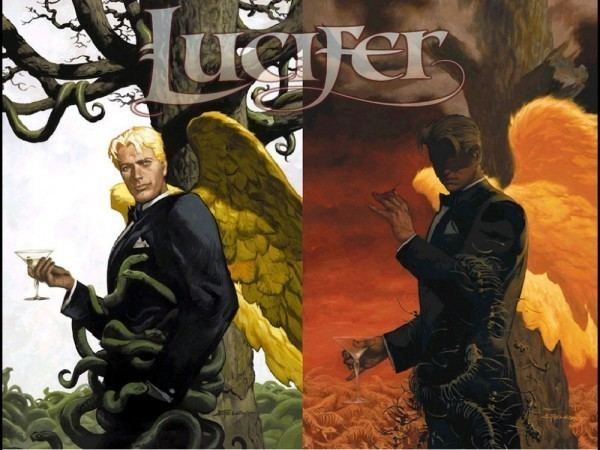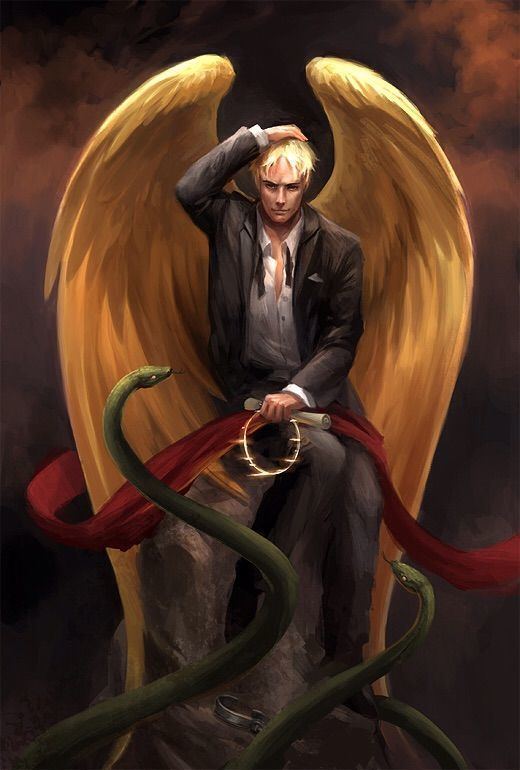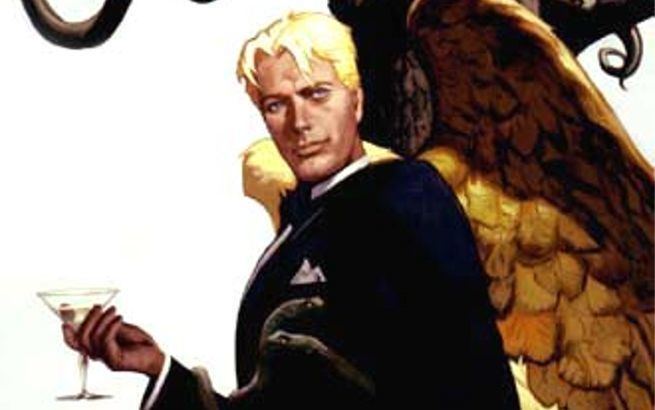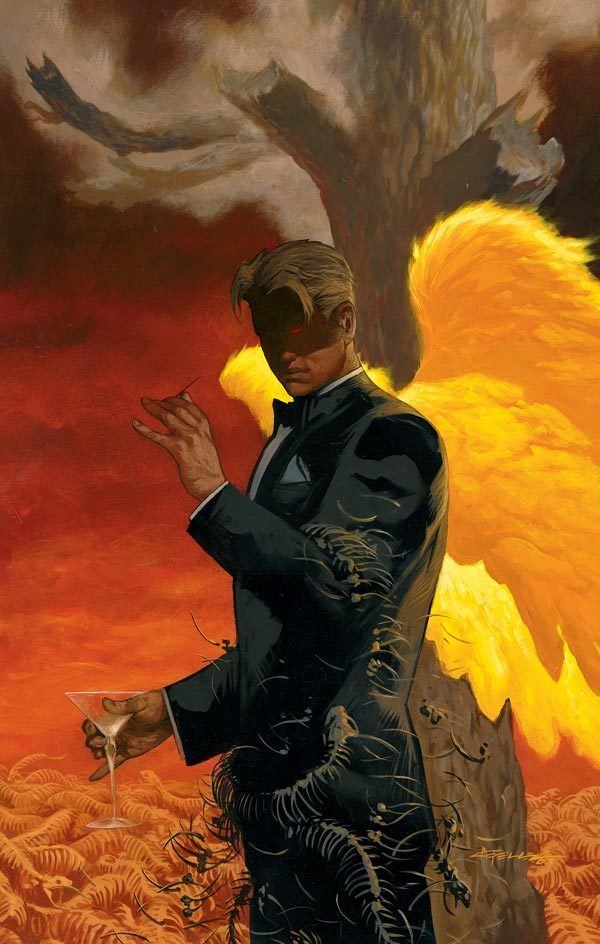Created by Neil GaimanSam Kieth Partnerships Mazikeen Partnership Mazikeen | ||
 | ||
Place of origin HeavenLucifer's CreationHell Team affiliations The Triumvirate of HellHost of HeavenLokiVarious characters who are willing to strike a deal with him First appearance The Sandman #4 (April 1989) Similar Mazikeen, Elaine Belloc, Presence, Dream, Michael Demiurgos | ||
Lucifer dc comics
Lucifer Morningstar is a DC Comics character appearing primarily as a supporting character in the comic book series The Sandman and as the title character of a spin-off, both published under the Vertigo imprint.
Contents
- Lucifer dc comics
- Sandman continuity
- Solo series
- The New 52
- Powers and abilities
- Other versions
- Film
- Television
- Paperback
- References

Though various depictions of Lucifer—the Biblical Fallen angel and devil of the Abrahamic religions—have been presented by DC Comics in their run, this interpretation by Neil Gaiman debuted in The Sandman in 1989.

Later, the character acquired an ongoing Lucifer spin-off series written by Mike Carey, depicting his adventures on Earth, Heaven, and in the various other realms of his family's creations and in uncreated voids after abandoning Hell in the Sandman series. Lucifer also appears as a supporting character in issues of The Demon, The Spectre, and other DC universe comics. Two angels, several demons, a human, and briefly Superman have taken his place as ruler of Hell.
In 2010, IGN named Lucifer as the 68th greatest comic book villain of all time.
Lucifer appears as titular character in a television series made by DC and Fox portrayed by Tom Ellis.
Sandman continuity
In the earlier related series The Sandman, written by Neil Gaiman, Lucifer abandoned his lordship over Hell. While Lucifer had previously appeared in various stereotypical guises in earlier DC books, Gaiman's version was premised on English poet and prose writer John Milton's Paradise Lost. At Gaiman's request of the artist, Lucifer looks like David Bowie at the time. In the Sandman series, Lucifer had ruled as Lord of Hell for 10 billion years after rebelling three seconds after Creation. Over that time, he had manipulated the various demons of Hell against each other, provided a place for dead mortals to be tormented, and led the war against Heaven.

However, at some point during his rule, he had become bored with his existence. He became tired of the various stereotypes and prejudices that mortals held of the Devil, such as the idea that he purchased and traded for souls, which were largely untrue, and that he forced mortals to commit evil acts. He had become tired of his reign over Hell, and felt it an unfair punishment that he should have to rule there forever simply because he once rebelled. In the Sandman story "Season of Mists", Lucifer expels all demons and damned souls from Hell before locking Hell's gates and handing over the key to Hell to Dream of the Endless, the title character of the Sandman series. Eventually, control of Hell was handed over to two angels, Duma (the angel of silence) and Remiel ("set over those who rise"), while Lucifer simply retired to Earth, initially to Perth, Western Australia and later to Los Angeles, California.

By the end of the series, however, it is revealed that Hell was not a punishment, but a gift: being the furthest possible place from the throne of light, Lucifer could be as separated from God as possible. Lucifer never created the physical features of Hell—Hell created itself around him.
Solo series
Lucifer was the main character in an eponymous series that ran for 75 issues and the Lucifer: Nirvana one-shot, from June 2000 to August 2006, the entire run of which was written by Mike Carey (this series was preceded by Carey's work in 1999, The Sandman Presents: Lucifer miniseries). To Carey, the essence of the character was:
We play safe. Most of us do, most of the time... but Lucifer doesn't know the meaning of safe, and he never bothers to look down at the tramlines. He goes wherever the hell he likes, picks his fights where he finds them and generally wins... following [his] own will and [his] own instincts to the very end of the line, no matter what the obstacles are star.
In the series, Lucifer runs a piano bar (an element introduced in the Sandman story "The Kindly Ones") called "Lux" in Los Angeles, with the assistance of his consort, Mazikeen who is a Lilim, one of the race descended from Lilith. Lucifer is portrayed as a sophisticated and charming man, in accordance with the stereotypical gentleman-devil.
The theme of the Lucifer series revolves around the free-will problem. Carey's Lucifer is a figure representing will and individual willpower, who challenges the "tyranny of predestination". While in Heaven's eyes this is blasphemy, Lucifer points out that the rebellion (and indeed all sin) and damnation as consequence were pre-planned by his Creator, God. Lucifer rejects God's rule and moral philosophy as tyrannical and unjust. The violent, aggressive, totalitarian, vengeful, and dictatorial aspects of Heaven's rule are represented mostly by the Angel, Amenadiel, who has a particular hatred of Lucifer and leads attacks of various kinds against him. The attacks include verbal criticism, marshaling the host of Heaven, as well as challenging him to individual combat—almost all of it without the slightest care for the countless innocent, unwilling and unwitting victims he is more than willing to sacrifice for his own pride. For his part, Lucifer disdains Amenadiel, treating the latter's emotional outbursts with contempt, and repeatedly defeats Amenadiel's assaults with well-orchestrated, hidden plans. Ironically, however, it is often difficult to discern when Lucifer acts as a slave to predestination and when he effectively acts according to his own free will.
Elaborate codes of conduct and schemes of entrapment based on these codes are vital elements of the DCVertigo magical universe. Lucifer appears as a master of these arts. In an encounter during the first Sandman story arc (around issue #5) a weakened Dream outsmarts Lucifer. Lucifer first swears revenge on Dream, but later comes to accept Dream's critique of his role and project as Lord of Hell. This inspires Lucifer's abdication, a vital element of the Sandman saga, and the point of departure for the Lucifer series.
For Lucifer, his word is bond. As David Easterman, a character who sees himself as a victim of Lucifer, puts it:
When the Devil wants you to do something, he doesn't lie at all. He tells you the exact, literal truth. And he lets you find your own way to Hell.
Despite his theological title as the "Lord of Lies", refusal to lie is central to the moral position of the character - he sees himself as a neutral or amoral facilitator of forces within individuals, and Lucifer actively and effectively combats what he regards as corrupting moral codes. While he avoids lying, his morality seldom extends to compassion, and Lucifer regards the sacrifice of millions of souls as unimportant collateral damage; there are few, if any, beings he respects and even fewer for whom he cares.
As the series opened in 2000, Lucifer's "restful" retirement was disturbed by a series of associates from his past. After various catalytic events, he endeavored to create a universe in competition with (and presumably against the wishes of) his father, Yahweh. This puts him on a collision course with several powerful mystical entities that have a vested interest in the new creation and draws the angelic host into the fray - including his brother, the archangel Michael Demiurgos, and his niece, Elaine Belloc.
The series paralleled The Sandman in several ways, with epic fantasy stories being told in arcs separated by one-shot episodes depicting a smaller, more personal tale. Unlike The Sandman, the series has had a consistent art team in Peter Gross and Ryan Kelly, with most of the odd issues illustrated by Dean Ormston. The title's 50th issue was penciled by P. Craig Russell, a homage to The Sandman #50. Structurally, the series mostly follows its own path. Numerous gods appear, with greater focus on Judeo-Christian religion (as viewed by John Milton in Paradise Lost), Japanese, and Nordic mythology than in Sandman. As for the Endless themselves, Dream, Death, Delirium, and Destiny appear, but their appearances are small and rare. Destiny, perhaps, plays the biggest role in so far as he represents predestination, which Lucifer of course finds "offensive as a concept," stating that Lucifer knows Destiny is "really just a SIDE effect of [Lucifer's] FATHER, or rather, his deterministic APPROACH to the act of creation."
Cover artists included Duncan Fegredo, Christopher Moeller and Mike Kaluta. The letters are inconsistent, with the first half of the series carrying particularly established fonts of Gaudium, Michael and God, only to drop almost all of them, save Lucifer's, towards the end with numerous changes in the letterers.
The series ended in June 2006 with issue #75 and has thus far been collected in eleven books, with a standalone story (Lucifer: Nirvana) published as a smaller graphic novel. The series' parent title, The Sandman, also ran for 75 issues.
When Lucifer ventures outside Creation, he sees something resembling the comics pages themselves. In the end of the Lucifer story arc, God and the Devil are no longer part of the universe, and a former human (Elaine Belloc) is instead presiding over it. New concepts for Heaven and Hell are created, inspired and influenced by other human or superhuman characters in the story. The new situation is described on several occasions by the fallen cherubs Gaudium and Spera. In essence, it is "growing up", i.e., the need to find one's own truth and values without being directed by parents, elders, teachers, authority figures, etc.
The New 52
The New 52 reinterpretation of Lucifer is much more influenced by traditional Christian theology. He is depicted as a malevolent, sadistic, and cunning fallen angel who is the ruler of Hell and seeks to possess human souls. He is held with great respect and fear by the denizens of Hell, who serve and obey him like a king. Lucifer himself however is mostly bored with his existence when the group known as the Demon Knights are captured by him during the early Middle Ages, and passes the time by finding small amusements, such as watching the struggles and falls of Etrigan the Demon.
Lucifer made a more physical appearance in I...Vampire #19 after being tipped by John Constantine in destroying Cain. Lucifer immediately sentences Cain and drags him to Hell. Though a being claiming to be him has appeared in the modern age of DC to the hero Deadman, the current whereabouts and status of Lucifer remain unknown.
Powers and abilities
Lucifer is continuously described as a celestial being of incalculable power due to his dominion over the very substance and knowledge of the formation of Creation. Through this understanding, Lucifer can shape the matter and foundation of Creation into anything he can imagine, including matter, energy, and more abstract concepts such as time. However, he does have certain limitations as he is still a creation of God; chiefly, he cannot create something out of nothing, unlike his Creator or brother. In some ways, this makes him the most disadvantaged, though not the weakest, of the higher angelic host. He needs existing matter (and where that is unavailable, the Demiurgic power of the Archangel Michael or that of God Himself) to provide the foundation for him to shape. Only his brother, the Archangel Michael Demiurgos, is his equal in power, and only God, his creator and father, is his superior. However, in certain dimensions for reasons unknown, he is powerless and his mobility is limited without his wings. He may choose to temporarily abandon his powers, including his immortality. In the story titled "Lilith", it is logically implied that God could destroy him at His own whim, which makes Lucifer sometimes wonder why He hasn't dealt with him already.
He is never without the formidable resources of his brilliant, nigh-omniscient intellect and his unbending will or inner strength, which allowed him to defy and confront his father as well as many other formidable opponents without fear or doubt. Although Lucifer's overt exercise of power is limited in the books, if he is provoked to violence, his preference seems to be to use fire and light as a weapon. His original role was as "God's lamplighter", in which he used his will to condense clouds of hydrogen into star-masses and set them alight. As terrifying as they are brief, battles with Lucifer usually begin and end with him drawing down the flames of a super-heated main sequence star and incinerating to ash anything in the immediate area. However, the true reasons why he favors light and fire are partially explained in the story "Lilith" (from "Lucifer: The Wolf Beneath the Tree").
Beyond his demigodly powers as an archangel, Lucifer possesses the common powers appropriate to an archangel of his position; incalculable physical strength, invulnerability, flight, acidic blood (or, rather, he bleeds willpower, as depicted in when he reaches Yggdrasil in "Lucifer: The Wolf Beneath the Tree"), a devastating sonic cry, telepathy, and the power to speak to and understand animals. As an archangel, his powers are significantly superior to other angels and put him well above such superpowered beings as Superman or the Specter.
In the New 52 reboot, Lucifer is shown to possess power over the human soul itself. However, he has no power over animal souls. He can open and close magical portals to Earth from Hell and back again. He can use this power to either summon or banish demons, as he does with Etrigan. He is clairvoyant, possessing a heightened perception or knowledge of time, even to the extent of being able to know the future.
Other versions
Film
Television
Paperback
Lucifer, including the Sandman Presents miniseries and the Nirvana one-shot, has been collected together into eleven trade paperbacks:
Note: The full title of all volumes listed here start with "Lucifer: ".
